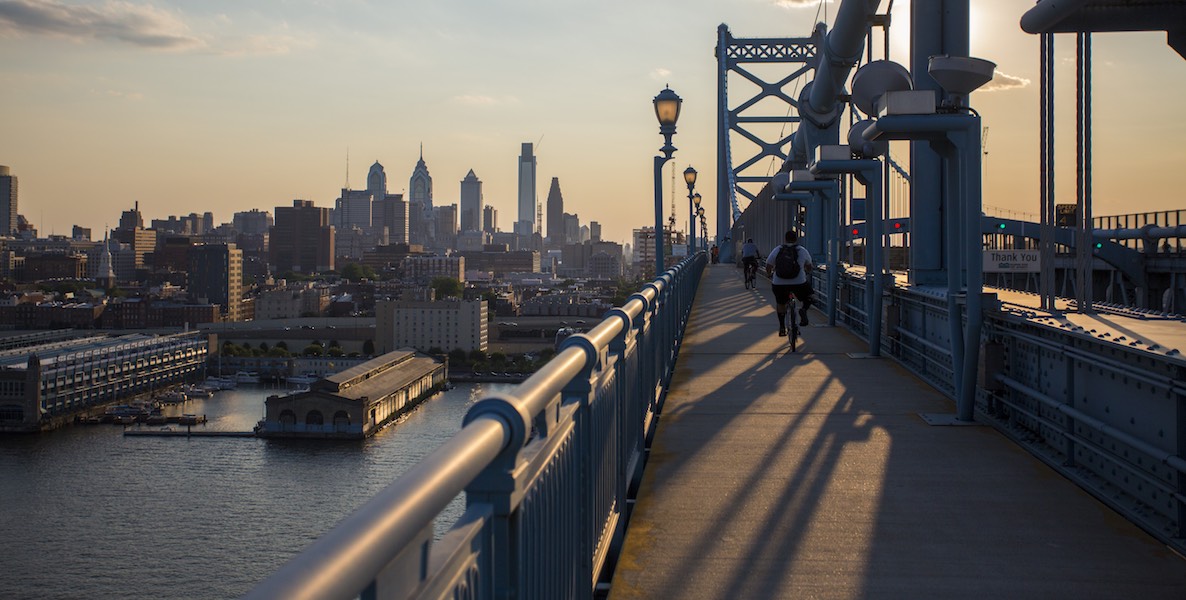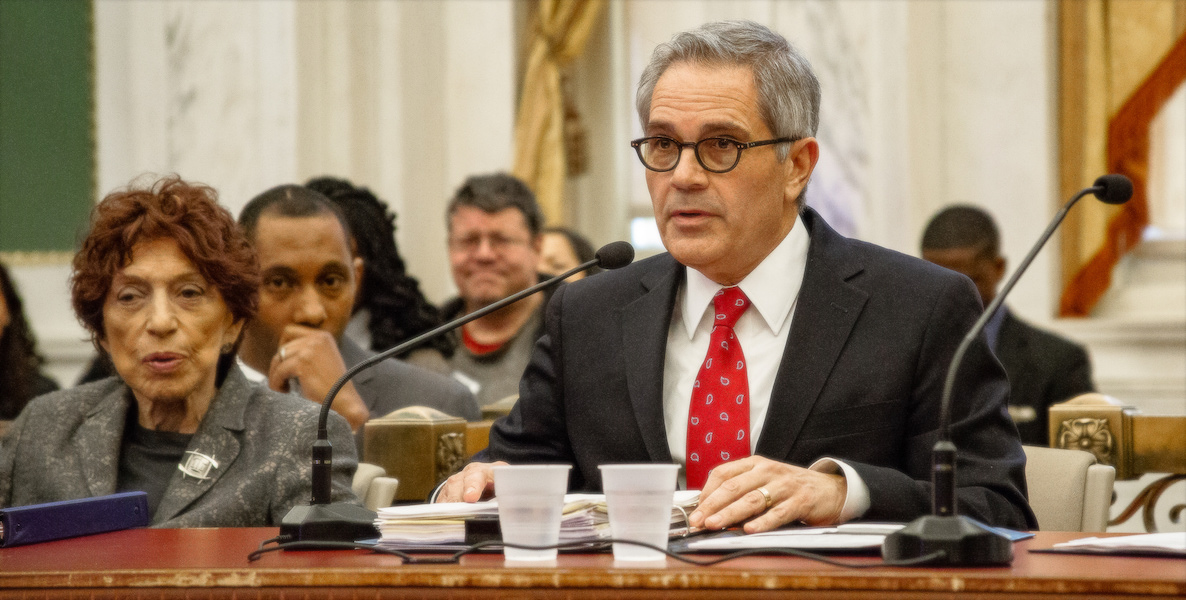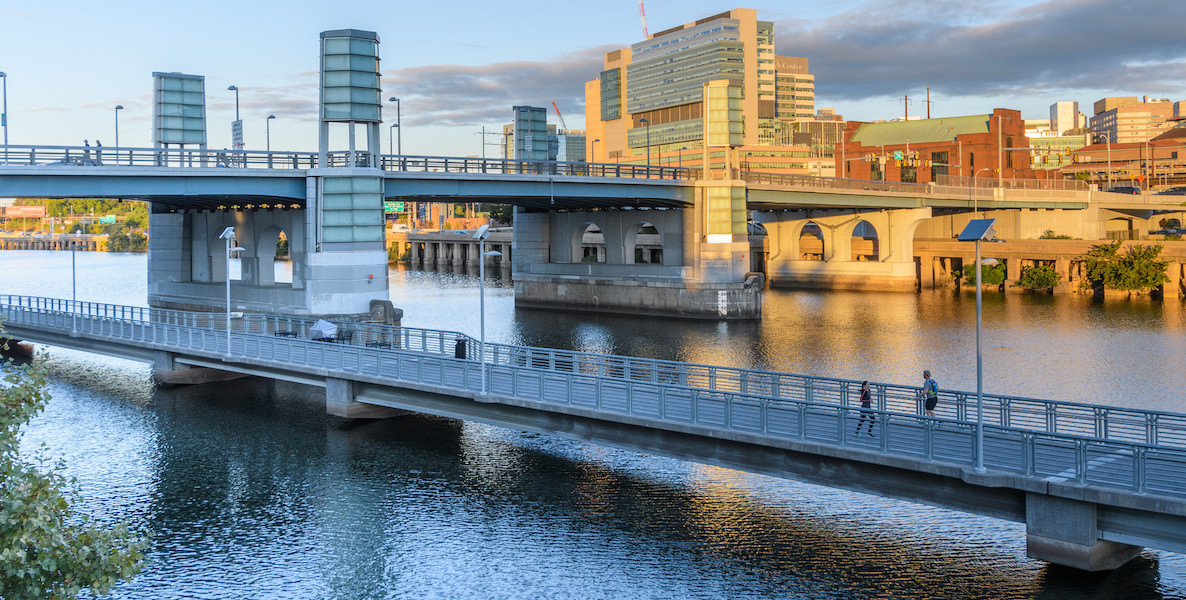Over three days I spent in Detroit, the people, the place, and the spirit captured my imagination. I was in Detroit to represent the Economy League of Greater Philadelphia at the annual meeting of the Governmental Research Association, a national network of independent state and regional think-tanks. The conference itself, organized by the Citizens Research Council of Michigan, was rich with thought-provoking panels and even more thought-provoking informal evening discussion at local restaurants and watering holes among a very sharp group of “meaning-makers and wayfinders” in GRA president Mebane Rash’s felicitous phrase.
Detroit and Philadelphia are about the same size, roughly 140 square miles. In 1920, Detroit was the 4th most populous city in the country, trailing New York City, Chicago, and Philadelphia. In 1950, the Motor City and the City of Brotherly Love both boasted roughly 2 million residents. Over the next 50 years, while Philadelphia lost 25 percent of its population to bottom out in about 1996 at 1.4 million, Detroit lost no less than 10 percent of its residents per decade, and today there are fewer than 700,000 souls residing there. For those of us who remember the Philadelphia of the 1980s or early 90s as a challenged place, Detroit’s challenges are another order of magnitude.
I often talk about two Philadelphias. The first, which I sometimes call “Boston-adelphia”—and which others call “Greater Center City”—is doing quite well: very high labor force participation, very low unemployment, high rates of educational attainment, rising property values, vibrant commercial corridors, low crime rates, relatively thriving neighborhood schools, etc. The other, which I sometimes call, yes, “Detroit-adelphia,” not so much: low labor force participation, high unemployment, low rates of educational attainment, declining real property values, moribund commercial corridors, blight, half empty and underperforming schools, etc.
My characterization is, of course, a dramatic over-simplification that ignores our many so-called ‘middle neighborhoods,’ but I think it is still a useful heuristic. That’s not to say that neighborhoods are uniformly rich or poor; in my own Queen Village, the disparities between the north and south sides of Christian Street are quite dramatic, as they are in many gentrifying neighborhoods. Yet heatmaps of the city by income, educational attainment, vacant properties, rising versus declining property values, and violent crime graphically illustrate the “tale-of-two-cities” phenomenon.
Detroit’s recovery, incomplete and uneven and uncertain and fragile as it may be, has been and continues to be a true team effort, a collaboration among the public, private, and nonprofit sectors, robust philanthropic support, and regional and state-level cooperation.
Since the near-bankruptcy of the early 1990s and the imposition of fiscal discipline by the Pennsylvania Intergovernmental Cooperation Authority, which floated the bonds that restored the City’s solvency, the City of Philadelphia has been on a positive trajectory. Budgets have been balanced; debt loads have been reasonable; the City’s credit rating has improved (in large part due to the Actual Value Initiative property tax reforms); the city’s competitive position has improved in part due to moderate wage and business tax reforms, in part due to rising tax burdens in the suburbs; there’s a plan to pay down some of the unfunded pension liability; population has grown along with the tax base; and we’ve seen decent job growth, particularly in the past ten years.
The City managed to ride out the Great Recession without fiscal calamity, in part due to sound fiscal management and in part due to the stability of our eds-and-meds economic base. We’ve seen at least two major waves of residential construction since the implementation of the generous 10-year tax abatement in the late 1990s, aided by the national “back to cities” trend; as leisure tourism has boomed and convention business has recovered in the wake of the expansion of the Pennsylvania Convention Center and the historic labor deal a few years ago, several major new hotels have been built; commercial office rents are at historic highs and vacancy is lower downtown than in the suburbs.
Yet these observations and aggregate statistics elide the fact that growth has been incredibly unevenly distributed. Over the past 20 years, Greater Center City has grown denser, richer, and whiter, while the rest of the City has declined in population, incomes have stagnated, and poverty remains stubbornly high at just under 26 percent.
What can we do about this disconnect between the prosperity in Boston-adelphia and the stagnation in Detroit-adelphia?
![]()
I signed on to lead the Economy League, with its history of data-driven civic innovation, in large part to attempt to figure out how to bridge this gap with a holistic, inclusive and equitable growth strategy. As I draft the Economy League’s strategic plan, a plan for all of Philadephia, I’m reading Equity, Growth, and Community: What the Nation Can Learn from America’s Metro Areas by Chris Benner and Manuel Pastor. It’s about the ways in which a select number of metro regions—not ours, sadly—have managed to link economic prosperity and social inclusion, and the importance of what they call “dynamic knowledge communities” in doing so. As Pastor and Benner put it “our ability to grow together may be fundamentally rooted in our ability to know together.” Which brings me back to Detroit…
By some measures Detroit is Philadelphia circa 1995—on the upswing after bottoming out. Reeling from the Great Recession, in 2009 Detroit’s unemployment level hit Great Depression-era heights at 28 percent. The first decade of the 2000s saw Detroit lose 25 percent of its population. The Motor City’s fiscal situation was so dismal that the State of Michigan imposed an emergency manager, who filed for the largest municipal bankruptcy in U.S. history in 2013. However, thanks in part to a so-called “grand bargain” that leveraged the art collection of the Detroit Institute of the Arts as collateral for over half a billion dollars in foundation support, Detroit emerged from bankruptcy a year later, much faster than expected. (Interestingly, part of the grand bargain included a 3-county levy that supports the operation of the DIA.)
I visited Recovery Park Farms, a remarkable urban farming initiative on 60 acres of vacant land that was once a densely populated working-class neighborhood of 2,500 people near GM’s huge Hamtramck Assembly Plant. It employs returning citizens and recovering addicts to grow food at commercial scale.
In the wake of the Great Recession, Quicken Loans founder and native son Dan Gilbert declared that he would invest a significant portion of his personal fortune in the revitalization of Detroit; to ‘walk the talk,’ he moved his company’s HQ to downtown, with what’s turned out to be roughly 15,000 jobs. Gilbert’s real estate company bought and rehabbed more than 90 downtown office buildings. Fellow billionaire and Little Caesar’s Pizza scion Chris Ilitch is investing heavily in revitalizing a large district that surrounds the new Detroit Redwings hockey arena. Today Detroit’s official unemployment stands at about 7 percent, downtown office vacancies are low, and cranes building new apartments dot the skyline.
I first visited Detroit in 2015, and downtown was still pretty desolate in the evening, reminiscent of Center City Philadelphia circa 1990. Three short years later the change, at least downtown, is astounding. The city center is bustling, with nice hotels, fancy shopping that rivals Walnut Street, dozens of bars and restaurants that are packed at night, lots of nice co-working spaces. There’s a new light rail line, the Q Line, that connects downtown and midtown, home of the Detroit Institute of the Arts and Wayne State University. There’s a can-do spirit in the air, almost a swagger.
It could be tempting to conclude that “Philadelphia has the 10-year tax abatement, Detroit has Dan Gilbert and Chris Ilitch.” And from the perspective of downtown Detroit, that might make sense. Yet just beyond the downtown core, there are huge swaths of vacant land and abandoned neighborhoods. The poverty rate is a crushing 36 percent. And despite a relatively low official unemployment rate, Detroit’s labor force participation rate, that is the proportion of working-age adults in the formal economy or looking for work, is about 54 percent, the lowest rate among the top 40 cities in the nation. (For comparison, Philadelphia’s is at about 59 percent, also quite low.)
![]()
Yet from my perspective on the ground, while Detroiters inside the downtown core are benefiting from direct investment by Gilbert, Ilitch, and others, those outside the core are making remarkable strides to turn challenge into opportunity. I visited Recovery Park Farms, a remarkable urban farming initiative on 60 acres of vacant land that was once a densely populated working-class neighborhood of 2,500 people near GM’s huge Hamtramck Assembly Plant, now reduced to fewer than 200 residents. Recovery Park is currently employing a dozen or so returning citizens and recovering addicts to grow food at commercial scale, driven by demand from Detroit’s burgeoning restaurant scene, with plans for growth that include major expansion of the greenhouse operation as well as an indoor hydroponic operation.
As fellow GRA participant Molly Osborne of EducationNC wrote in a recent summary of her Detroit experience, “Most states do not have a Detroit… but the city’s decline and recent comeback offer lessons to all of us.” After three days interacting with Detroit leaders and exploring the city, my initial thoughts on these lessons are: Detroit’s recovery, incomplete and uneven and uncertain and fragile as it may be, has been and continues to be a true team effort, a collaboration among the public, private, and nonprofit sectors, robust philanthropic support, and regional and state-level cooperation. In sum, it seems like it could have the hallmarks of sustainability.
Which brings me back to Philadelphia. It is undeniable that the City of Brotherly Love is presently in better shape than Detroit, in aggregate, by most indicators. Yet our City’s current trajectory is also quite fragile, incomplete, and uneven. Though we have a stable economic base of “eds, meds, and beds,” current growth rates are insufficient on their own to lift tens of thousands out of poverty and into decent-paying jobs. While we are starting to come to terms with what the City’s Managing Director Mike DeBerardinis calls “managing growth rather than decline,” we seem to fall a little short not only in the self-confident swagger of Detroit but also in the realms of civic infrastructure, philanthropic support, and regional cooperation.
As United Way CEO Bill Golderer noted in his eulogy/call to action in the wake of the recent deaths of both Jeremy Nowak and H.F. “Gerry” Lenfest, neither “shied from stepping into those critical moments that can change another’s life, and each devoted a lifetime to addressing complex issues through advocacy and philanthropy… And so must we.”
We at the Economy League are looking forward to addressing these complex issues in new ways. We will be taking 145 cross-sector leaders to Seattle next month to learn how that city has dealt with unfettered growth. We’re launching a civic incubator this fall called GPLEX Labs, with a public policy challenge and fellowship program. We’re building out the Anchor Procurement Initiative to create inclusive growth and jobs by leveraging institutional purchasing power. And we will continue producing high-quality independent analysis and insight to help civic leaders make data-driven decisions.
From Boston-adelphia to Detroit-adelphia, we want all of Philadelphia to feel a can-do spirit in the air, a swagger, a capacity to grow now and in the future together.
Jeff Hornstein, the Executive Director of the Economy League of Greater Philadelphia, formerly served as the Policy Director in the Office of the City Controller. This piece also ran in the Economy League’s monthly newsletter.
Photo: Peter Miller via Flickr (CC BY-NC-ND 2.0)





